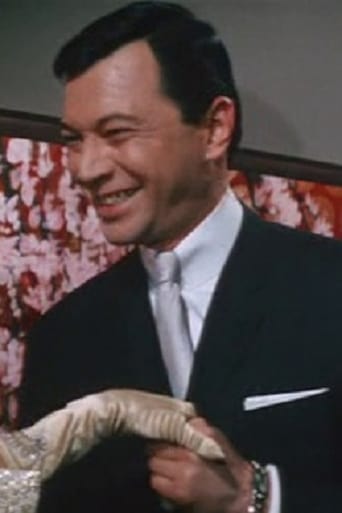TrueHello
Fun premise, good actors, bad writing. This film seemed to have potential at the beginning but it quickly devolves into a trite action film. Ultimately it's very boring.
Michael O'Keefe
British producer/director George Breakston presents a campy Japanese horror flick that is unintentionally funny as well as a bit creepy. American reporter Larry Stanford (Peter Dyneley) is on assignment in Tokyo to interview a crazed scientist Dr. Suzuki (Tetsu Nakamura), who is experimenting with mutations. The doc is impressed with Stanford's manliness and decides to prepare him for an experiment and offers him a drink. The atmosphere to blame, the reporter feels a bit woozy before changing his total personality. He begins drinking heavily and easily becomes a womanizer; especially finding a fondness for Suzuki's assistant Tara (Terri Zimmern). After a binge of bad behavior, Stanford begins sprouting hair and another head on his shoulder. Black and white thriller of a hapless reporter battling himself; half-man, half-monster.Other players: Norman van Hawley, Jane Hylton, Jerry Ito and George Whyman.
Rainey Dawn
This film surprised me - better than I ever expected it to be. Something about it reminds me a little bit of Jekyll & Hyde and to a lesser degree The Wolf Man... I can't place my finger on it but I think it was the chase scenes. The Manster may not be quite as good as the 2 films I mentioned but it's almost to the level of them - quite a good film.A mad scientist is interviewed about his amazing experiments. The scientist feels the reporter would make the perfect subject for his most diabolical of experiments which turns the reporter into a two-headed creature - a killer.This one is a little bit above average on the 1950's horror b-films - they really went all out for the film. As one reviewer said "This is a film waiting to be re-discovered".5/10
Lee Eisenberg
"The Manster" is the sort of movie that only Elvira, Joe Bob Briggs, or the "MST3K" crew could present. I saw the Mistress of the Dark's presentation. While watching there were some things that I noticed:*There's a white person cast as a Japanese.*The discussions between the reporter and scientist border on a bromance.*The song played on the instrument in that one scene sounds like a blues song.And then of course the eye reminded me of "Army of Darkness". As for Elvira, she learns that her green card has expired - she apparently comes from Transylvania - and she's facing deportation. But of course she never stops offering pun-filled commentary on the movie. It's the average so-bad-it's-good flick featuring dated gender relations. Always fun to watch.Elvira should sing a blues song about B movies, complete with puns.
henri sauvage
This bizarre hybrid of film noir, Two-Headed Thing yarn and Dr. Jekyll and Mr. Hyde has its share of flaws, there's no denying that. Between its obviously limited budget, cheap sets, a cast of no-name American and Japanese actors and some awkward dialog, it's a bit of a wonder that "The Manster" turned out to be such an effective little nightmare.The movie begins with the shocking murders of three Japanese women by a dimly-seen, Yeti-like monster, in a bath house, concluding with the obligatory splash of blood on the shoji, over which the opening credits run. Next we see "eccentric" Dr. Suzuki, played by Tetsu Nakamura -- who in fairness was a pretty well-known actor at the time in Japan -- trudging up a mountain slope to his residence. You have to hand it to Dr. Suzuki for choosing such an inaccessible spot: not only is it likely to discourage Jehovah's Witnesses and suchlike nosy parkers, it's got a great view of the neighboring volcano -- even if it's only a model.Arriving at his hideaway, Dr. Suzuki is warned by his beautiful and mysterious assistant Tara (Terri Zimmern) that Kenji is waiting for him in the lab. (Suzuki has a basement laboratory where he grows giant fungi, keeps his insane and hideously deformed wife Emiko -- Toyoko Takechi -- in a cage, and conducts his horrific experiments.) Turns out Kenji is the monster. He attacks Suzuki and starts wrecking the lab, but the not-so-good doctor manages to dispatch him by shooting him several times and giving him a dose of radioactive(?) steam for good measure. Shortly afterward, dull, strait-laced reporter Larry Stanford (Peter Dyneley) shows up on Dr. Suzuki's doorstep to interview the doctor about his oddball theories on evolution. Larry's not all that interested in the assignment: he's just marking time for a couple of weeks before he gets rotated from his syndicate's Far East bureau back to the States and the arms of his loving wife. So he's easily persuaded to have a drink with the jovial doctor.Bad move: Suzuki drugs Larry's drink, then injects him with the latest version of his experimental enzyme. When Larry wakes up, he chalks the whole thing up to fatigue and bad Japanese liquor, and heads back to Tokyo.The first effect of the enzyme is to turn Larry into a jerk. Instead of going home, he starts partying hearty and taking in the bright lights of Tokyo. Dr. Suzuki -- who wants to observe the effects of his latest experiment at first hand -- turns up again and befriends Larry, promising to show him "the real Japan". He persuades Larry to be his guest at a hot springs and mountain resort where he's introduced to Tara. Larry and Tara begin a whirlwind affair, while his increasingly frantic wife wonders what's happened to delay him.Then the plot switches from "Lost Weekend: Japan Style" into something much darker, as the enzyme triggers more intense mental and physical manifestations. Larry's right hand mutates into a hairy claw, and he takes to prowling the deserted streets and back-alleys of Tokyo at night, compulsively murdering first a Buddhist priest at his prayers, and then a couple of young women. As the changes become more pronounced and grotesque (including one of the most memorable images in the film) Larry leaves a trail of corpses behind him, until the final confrontation back at -- you guessed it -- Dr. Suzuki's volcanic hideaway. While the volcano explodes, naturally.This is one of those rare movies where the tight budget mostly works in its favor. It's shot in black and white, in sparsely furnished interior sets. The exterior shots take place mostly at night, in dark streets and alleys, a temple and a graveyard. The cinematography is pretty good, at times even atmospheric and disturbing. Dyneley does a fairly passable job as a hapless guinea pig for Suzuki's mad science, going from nice guy to abusive alcoholic philanderer to monstrous serial killer with an extra head growing out of his shoulder. Setting the story in Japan only adds to the weirdness and disorientation, as well as nicely emphasizing Larry's isolation.I wouldn't call this a masterpiece of horror cinema, but more like Early Grindhouse. Nonetheless, it's in many ways a profoundly strange little movie, well worth a viewing.





